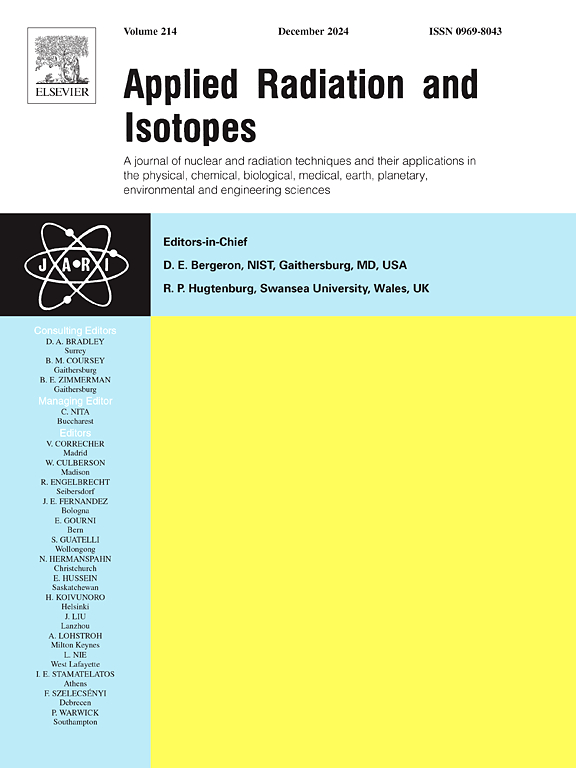Optimization and automation of the radiosynthesis of PET ligand targeting Aβ for imaging cerebral amyloid angiopathy
IF 1.6
3区 工程技术
Q3 CHEMISTRY, INORGANIC & NUCLEAR
引用次数: 0
Abstract
Cerebral amyloid angiopathy (CAA) is a common cerebrovascular disorder characterized by the accumulation of beta-amyloid (Aβ) plagues in cerebral blood vessels. A precise diagnosis of CAA is crucial for informing treatment decisions and evaluating the efficacy of therapeutic interventions. We previously reported a novel radiopharmaceutical, [18F]K10-008, that selectively targets Aβ deposits within the vascular walls of CAA patients. To facilitate its application in clinical settings, we present an optimized labeling protocol for [18F]K10-008, along with a comprehensive automated synthesis methodology. We systematically evaluated optimal labeling conditions, including the amount of precursor, reaction temperature, various fluorination reaction solvents, and deprotection acids, through laboratory experiments, which were subsequently adapted for automated production using the ALLINONE synthesis module. Our findings demonstrate that clinical doses of [18F]K10-008 can be produced in a synthesis time of 48 min–48 min and 20 s, achieving exceptional radiochemical purity (>98 %) and an activity yield of 6.73 % ± 1.78 % (decay corrected). Quality control assessments confirmed that all parameters met release criteria. In conclusion, we have successfully produced [18F]K10-008 with adequate radioactivity and outstanding quality, positioning it for future clinical applications in CAA imaging.
靶向Aβ的PET配体放射合成用于脑淀粉样血管病成像的优化和自动化
脑淀粉样血管病(CAA)是一种常见的脑血管疾病,其特征是β -淀粉样蛋白(a β)斑块在脑血管中积聚。CAA的精确诊断对于告知治疗决策和评估治疗干预措施的有效性至关重要。我们之前报道了一种新的放射性药物[18F]K10-008,它可以选择性地靶向CAA患者血管壁内的a β沉积。为了促进其在临床环境中的应用,我们提出了一个优化的标记方案[18F]K10-008,以及一个全面的自动化合成方法。我们通过实验室实验系统地评估了最佳标记条件,包括前驱体的数量、反应温度、各种氟化反应溶剂和脱保护酸,随后使用ALLINONE合成模块进行了自动化生产。我们的研究结果表明,临床剂量的[18F]K10-008可以在48 min - 48 min和20 s的合成时间内合成,获得卓越的放射化学纯度(> 98%)和6.73%±1.78%的活性产率(衰变校正)。质量控制评估确认所有参数符合放行标准。综上所述,我们成功生产出了[18F]K10-008,具有足够的放射性和出色的质量,为未来临床应用于CAA成像奠定了基础。
本文章由计算机程序翻译,如有差异,请以英文原文为准。
求助全文
约1分钟内获得全文
求助全文
来源期刊

Applied Radiation and Isotopes
工程技术-核科学技术
CiteScore
3.00
自引率
12.50%
发文量
406
审稿时长
13.5 months
期刊介绍:
Applied Radiation and Isotopes provides a high quality medium for the publication of substantial, original and scientific and technological papers on the development and peaceful application of nuclear, radiation and radionuclide techniques in chemistry, physics, biochemistry, biology, medicine, security, engineering and in the earth, planetary and environmental sciences, all including dosimetry. Nuclear techniques are defined in the broadest sense and both experimental and theoretical papers are welcome. They include the development and use of α- and β-particles, X-rays and γ-rays, neutrons and other nuclear particles and radiations from all sources, including radionuclides, synchrotron sources, cyclotrons and reactors and from the natural environment.
The journal aims to publish papers with significance to an international audience, containing substantial novelty and scientific impact. The Editors reserve the rights to reject, with or without external review, papers that do not meet these criteria.
Papers dealing with radiation processing, i.e., where radiation is used to bring about a biological, chemical or physical change in a material, should be directed to our sister journal Radiation Physics and Chemistry.
 求助内容:
求助内容: 应助结果提醒方式:
应助结果提醒方式:


